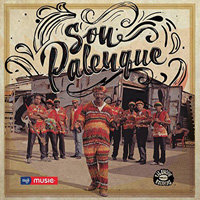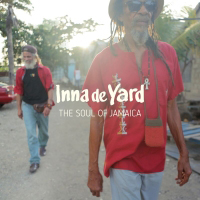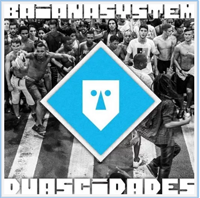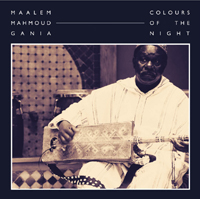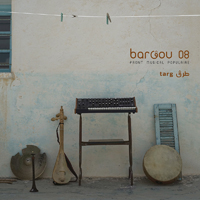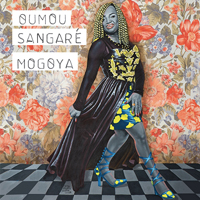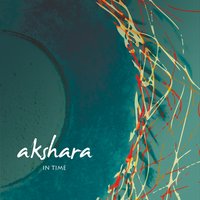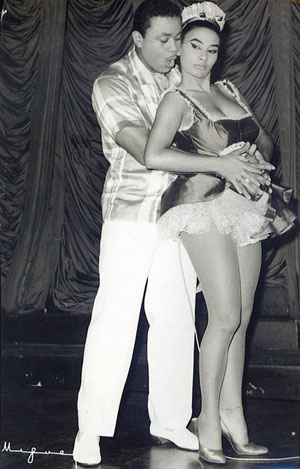Top 10 reissues of the year:
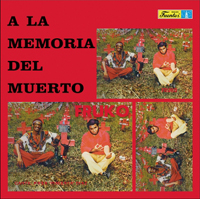
|
When Piper "Pimienta" Díaz died (murdered in front of his home in June 1998), a tribute album was issued by his label Discos Fuentes of Colombia that included a photo of him looking like a dolled-up corpse on the cover, so my cynical musical friends called it the "dead man" album. I am sure this put off potential buyers, but it rapidly became one of my favorite albums. Díaz had been the singer for two of Colombia's biggest bands: Fruko y sus Tesos and the Latin Brothers. Now the European label Vampisoul has reissued Piper's first album with Fruko from 1972. The style, known as salsa brava, has a hard sound with percussion to the fore and big blasts of brass from three trumpets and two trombones. There are many styles represented, including the traditional bomba and plena of Puerto Rico, guaguancó, oriza, and cha cha chá from Cuba, and the New York-bred Latin soul and descarga, all of which found a fertile home in Cali in the 1970s. Piper Pimienta (born Edulfamid Molina Díaz) brought an energy and intensity to the sound that matched Fruko's arrangements and the stark engineering by Fruko's uncle Mario Rincón. This was the group's second album and is mostly cover versions of guaranteed dance hits, some from the 50s, showing the continuity of Latin music in Colombia. This album is what propelled Díaz to fame alongside Joe Arroyo, another Colombia superstar who joined him in the Latin Brothers. For an hour of pure unbounded joy you won't find better than this.
|
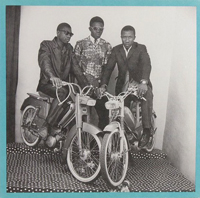
|
ORIGINAL SOUND OF MALI (Mr Bongo)
I am very greedy when it comes to classic Malian, Senegalese and Guinean music of their golden era, which spans post-Independence in 1960 through the 80s. As much as I discover, there's always more, and I am grateful to people like Graeme Counsel, Florent Mazzoleni, Adamantios Kafetzis of Teranga Beat, not to mention Stern's, Kanaga System, Dakar Sound and all the independent labels who find this music and restore it for us. This latest reissue from Mr Bongo is simply stunning. Looking at the tracklist you might see "Mandjou" by Les Ambassadeurs, and tracks from Rail Band and Super Djata and think to yourself, I probably have these. But chances are you don't have more than two or three of these tracks, not because they are obscurities, but because they are super-rare gems. I know, you are saying, But I have the 6-disc Rail Band set from Sterns (STCD3033-34, 39-40, 43-44), but you still don't have "Mouodilo" (a solid funk track, it came out on 45 from HMV in Nigeria!), and you might have "Fatema" by Ambassadeurs or Sory Bamba's "Yayoroba," but that still leaves a stack of stuff you need, like the two impossibly scarce and fabulous Idrissa Soumaroro tracks with his band L'Eclipse de l'I.J.A., the overlooked but far from slack Tentemba Jazz, and the Super Djata tracks which have never been reissued to my knowledge (They don't even show up on discogs.com). Idrissa Soumaroro is less well-known than other alumni of Les Ambassadeurs du Motel, and there are two cuts from his solo venture (Ampsa, 1978) presented here, bracketing the whole package: they are in a steaming R&B vein with great organ, congas, funk & rock guitar: a nice change from Afrobeat. "Fama Allah" made me think of "You keep me hanging on" as covered by Vanilla Fudge. His band L'Eclipse consisted of some of his blind students from L'Institut des Jeunes Aveugles in Bamako, including Amadou (on guitar) and Mariam (on vocals) who later had a successful breakout career in Europe and America. Back then, the European and American influences were grafted onto traditional melodies and lyrics, though occasionally some broke from tradition, like Sory Bamba whose hit "Ya Yoroba" celebrated women with large breasts. With his swirling electric organ, his group, Kanaga de Mopti, were compared to Pink Floyd. Super Djata had a wider repertoire, stylistically, than the other bands and also came to their peak powers during the 80s when the other big name bands -- Les Ambassadeurs and Rail Band -- were dropping off in popularity. In addition to Rail Band's Djelimady Tounkara and Super Biton's Mama Sissoko, Super Djata's Zani Diabaté is one of the great African guitarists. Compared to Magic Sam, Freddie King and even Hendrix, he was also a renowned percussionist and dancer. The booklet shows the covers of five Super Djata LPs that I have never seen, nor heard of before. The three tracks here stand up to the best of Ambassadeurs and the other class acts present. The whole album shows many facets of some musicians as they appeared in different configurations. The producers refer to one of "the heaviest Afro Funk cuts, 'Moko Jolo' of Rail Band" (which is on their 1973 "blue" album, Serie Folk-Rail 1, but not included here). I guess they are leaving some stuff on the side for a further smorgasbord. It's a great jam, but currently only available on a 2011 Japanese import replica CD of the original album which has three other cuts which are not in print. But there's enough here to satisfy you and broaden your collection of fabulous classic Malian music. |
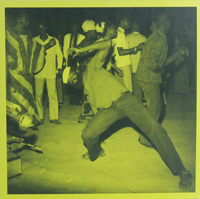
|
Hot on the heels of their fabulous Mali compilation, Mr Bongo drops another sonic bomb: this time from Burkina Faso, a landlocked country surrounded by Ivory Coast, Mali, Ghana, Niger, Benin and Togo. So now you know where it is: there will be a test. As Upper Volta the country was part of French West Africa so predictably is a gathering of people from different ethnic groups which span the country's borders. In addition musicians had to go abroad to record so were influenced by what they heard on these trips. Musically the compilation provides a wide variety of treats. It's not all sunshine and lollipops, there's the inevitable disco number, and you surely have the Amadou Balaké tracks already, such as the definitive Latin version of "Whisky et Coca-Cola" and "Super bar konon Moussa," that churns the funk. You may also have sprung for Bobo Yeyé, the 3-disc set that came out last year from the Numero Group, which was distinguished by a lovely hardback book of the B&W photos of Sory Sanlé (It has the photo of the guy on a moped on the cover). "Sie Koumgolo," as well as "Super bar konon Moussa," were on Analog's Bambara Mystic Soul; "A son magni" and "Yamb ney Capitale" -- Pierre Sandwidi's rocking closer -- were on Ouaga Affair (another fine comp); while others were in the Bobo Yeyé box. However there are plenty of rarities here, including the kicking lead-off cut "Jeunesse Wilila" by Abdou Cissé which you really don't want to fade out when it does. "Djanfa Magni," a famous Manding ballad which was popularized in Mali, is covered in a great version by Youssouf Diarra. Mangue Kondé's guitar playing here, with both 5 Consuls and Super Mande, is outstanding, pushing him up to the level of Sekou "Bembeya" Diabaté. The important thing is Burkina Faso's musical heritage is finally getting its due. Soon Volta Jazz, Super Volta, Dafra Star and Les 5 Consuls will be as well known as the big bands from neighboring countries thanks to the excellent detailed histories of the bands by compiler Florent Mazzoleni, and CDs such as this. We want music to suggest an alternative past for us, and this Voltaic outpouring speaks to our soul, singly or collectively: we find something familiar in it right from the start. It may have been around as long as we have and while we were listening to Paul Jones of Manfred Mann singing "Do wah diddy diddy," some kid in Ouagadougou was digging Amadou Balaké singing "Aminata" -- it's almost as if we swapped memories or recognized each other in a parallel mirrored universe. This music, so familiar after hearing it once (after all it has guitars with wahwah pedals and fuzztone, Hammond organs, saxophones), now speaks to us of our whole life, our loves and disappointments (to paraphrase Oscar Wilde in "The Critic as Artist"). What more could you want. |
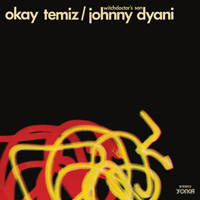
|
OKAY TEMIZ / JOHNNY DYANI
WITCHDOCTOR'S SON (Matsuli Music)
Matsuli step outside their normal Azanian comfort zone for this package, the latest installment in their growing collection of fine jazz reissues. This rare album came out in Turkey in 1976. It's expressive, experimental and above all engaging. The invisible catalyst is American avant garde trumpeter Don Cherry. Johnny Dyani had gone to London from his native South Africa in 1964, still in his teens, as bassist for jazz group The Blue Notes with Chris McGregor and Dudu Pukwana. After five years Dyani decided to try his luck in Copenhagen and ran into Don Cherry who was performing with a Turkish drummer, Okay Temiz. The three soon formed a trio and toured Europe and America from their base in Stockholm. They recorded with Abdullah Ibrahim on piano in 1970 and 71. From a teenaged student of hard bop, Dyani had absorbed Cherry's idea about global music, involving all styles and any influences, whether Chinese, Turkish or from elsewhere, including South African folksongs and rural music that Dyani could bring to the mix. He and percussionist Temiz had forged a bond that also led to their explorations with other South African, Turkish and Swedish musicians in a variety of configurations. The culmination of their search for a successful mix between jazz and folklore led to a trio with Mongezi Feza of the original Blue Notes, who was also well-versed in the marabi music of the shebeens back in South Africa. Sadly Feza was committed to a London hospital where, neglected, he contracted pneumonia and died. In 1976 the surviving duo had a residency in Istanbul and decided it was time to record their ideas: side one would be the Turkish side, and side two the South African side, with invited Swedish and Turkish musicians improvising live. On the traditional Turkish tunes, Saffet Gündeger features on violin and clarinet. Recorded in two days, this album fulfills the aims of two inspired performers and, though they are not present, the spirits of their brothers in music, whether Cherry (via his tune "Marimba [Mother of music]") or Abdullah Ibrahim (whose influence can be heard in Dyani's piano on here), are represented. It's a remarkable journey and a truly great rediscovery. |
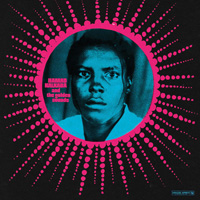
|
HAMAD KALKABA & THE GOLDEN SOUNDS
1974-5 (Analog Africa 24)
Analog Africa is one of the most prolific, diverse and provocative labels going. It focusses on reissues and has created a fabulous back catalogue of music we never even knew existed, from all over Africa. And Analog Africa strides ahead with yet another fantastic reissue, the second or third this year (depending whether you count disco). We are still digesting Los Camaroes' stellar album, which reappeared this summer, and here comes another previously unknown gem. This short album presents the complete works (3 singles or 6 sides) of Hamad Kalkaba backed by a band who I am pretty sure are not the same Golden Sounds of "Zangalewa" fame. The "continuing adventures of Samy" fill us in on the story of how label boss Ben Redjeb found a single by this artist and then went on a quest for more works by this one-time master of a particular Northern Camerounian rhythm known as the Gandjal. Finding the music was tough, but it was not hard to track down the artist, for, once identified, he was known to everyone as a retired colonel who had gone on to the nation's Olympic committee and thence to head the Confederation of African Athletes. As a soldier Kalkaba joined the band of the Republican guard and rose to be leader, learning the various instruments along the way. But at the time, 1970, they played European music and he wished their own rhythms could be showcased the way Makossa and Bikutsi were being performed in other parts of the former French colony. (Originally a German territory, Cameroun was divided between Britain and France after WW1, but when Independence loomed in 1960, the Northern British part opted to join Nigeria.) Like other African artists of the 70s the aim of young Camerounian musicians was to take traditional rhythms and modernize them with electric guitars, keyboards and drum kits. "Lamido," one of the harsher cuts on here, has an attack reminiscent of Fela, a grindingly funky groove, yelled vocals and an ominous organ hovering in the back with even more threatening horns punching through as the vocalist grunts "Bismillah!" I have no doubt these were massive hits in their day and shocked the people with their bold thrust away from the traditional thumb piano and rattles into electric big band sounds. They even turned some of these traditional songs into military marches. They did include a balafon and talking drum in the lineup but these recordings were made in a Protestant mission and consequently the mikes are not balanced, which is why there is a distant rumble from some of the less-audible instruments. "Gandjal kessoum" kicks right in with wild drums and wildly flailing sax in a hot take. The lyrics (which are included) are socially conscious and show how Kalakaba could have been a transformative force as a singer had he chosen to continue that career. But after his band appeared at Festac '77 as representatives of Cameroun he decided to devote himself to the more secure career of the military. This is short, sweet and mighty fine. |
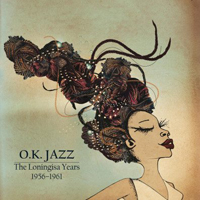
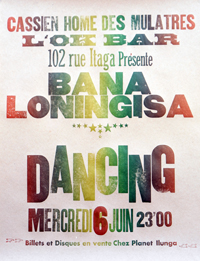
|
OK JAZZ
THE LONINGISA YEARS 1956-61 (Planet Ilunga 3)
On 1 September 1950 Henri Bowane cut the first disc for the Loningisa studios, opened by the Papadimitriou cousins, who were textile merchants in Leopoldville. Over a decade later, on 3 May 1962, the artist known as Geraldo waxed another rumba titled "Yo canto para ti" as the four hundred and first disc issued on 78 from Loningisa. In a handwritten note on their catalogue, deposited with the Belgian copyright society SABAM (& reproduced on the Worldservice blog) they state: "We have given up recording because of the political situation." Later, they stated that after President Mobutu declared the Republic of Zaire on 30 November 1973 they were forbidden, as foreigners, from continuing their commercial enterprises.
The Papadimitrious were one of four foreign enterprises (the others were Olympia, Ngoma and Opika) who specialized in producing Congolese rumba records for the local market. During those 12 years they nurtured some considerable talents and, as it turns out, half of their recordings were by members of a group that became known as OK Jazz, though they were essentially Bana Loningisa -- "the kids of Loningisa studio."
Bart Cattaeart has assembled 32 pristine tracks here, none of which are on the other key albums of this group's early days: Originalité (Retro2XCD 1999), with 20 tracks, or Roots of OK Jazz (Crammed Disc CRAW7 1993), with 19 tracks. But as Bart says, 90% of Congolese music from the 78 era has not made it to the digital age.
In volume one disc one of his 4-disc collection of the career of Franco, Francophonic, Ken Braun included 3 cuts by Bana Lonigisa (from Crammed's compilations) and three from Originalité, the famous "On entre OK, on sort KO (You come in fine, you leave knocked out)" and the blistering love song not about Demi Moore: "Tcha tcha tcha de mi Amor." But other early tracks have been hard to find. After De Wayon brought young Franco to the Papadimitrious to audition, the stable of musicians came together. Bassist Roitelet and singer Vicky came from the CEFA label, followed by guitarist De La Lune, singer Rossignol and clarinetist/saxophonist Jean-Serge Essous. Vicky had wanted to be an accountant but was soon busy as vocalist with both OK Jazz and Negro Succès. The band came together with a live gig at the OK Bar in the Mulattos Home, run by Gaston Cassien, himself a Belgian kid with a Congolese mother. Essous was chef d'orchestre and the musicians above were augmented by Pandi Saturnin and Dessoin on congas. Bowane took a huff over being left out and quit to work for a new label (run by another Greek businessman): Esengo (built on the remains of Opika), where he would gradually lure Rossignol, Roitelet, Pandi and Essous to form Rock-a-Mambo. Isaac Musekiwa was brought from African Jazz to fill the big hole left by Essous' departure, so there could be interplay between the horn and Franco's dazzling guitar. Trumpeter Willy Kuntima and another guitarist, Brazzos, joined in 1957. In 1959 there was another shake-up with half the band leaving to join half of Rock-a-Mambo in creating the Bantous de la Capitale in Brazzaville. Guitarist Brazzos and singer Vicky left to go the Table Ronde summit in Brussels with members of African Jazz; Franco was invited too but his wife Pauline forbid him to go. He struggled to continue but from then on OK Jazz was his band, and he increasingly put his personal stamp on it.
Like the music of African Jazz, Rock-a-Mambo and the Bantous, the early OK Jazz repertoire was deep into the Afro-Cuban boleros, rumbas, merengues, cha-chas and the occasional calypso. Franco even adapted Bakoko folklore, but by the late 60s he was forging the rumba-odemba sound with which he is most strongly identified. The 32 tracks here are in many ways similar to those other bands' repertoires, except in the "guitare parlante" and of course the vocalists. Cattaert has put together as wide an array as possible of styles, even including Colombian porro and Brasilian samba.
In contrast to Sonodisc who put out some early Franco material from unrestored records with no information other than title (often mis-spelled) and composer, Planet Ilunga has done an exceptional job of restoration, with the needed information. There is one slightly muddy track at the end "Bana OK Jazz": one assumes it was impossible to find a copy that had not been worn out on the Victrola. I had heard 8 or 9 of these tracks before from traders who had thrashed 78s, so the clean sound is a joy and a revelation. You won't find this exquisite music elsewhere, and it is a limited-edition pressing, so grab your copy a.s.a.p.
Note: I printed up an imaginary poster for the first OK Jazz gig at Cassien's Home of Mulattos in Léopoldville, 6 June 1956 [left]. Planet Ilunga gave these away with the first 80 orders; I have a few left, which are available from my Etsy page.
|
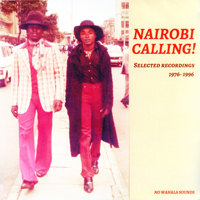
|
NAIROBI CALLING!
SELECTED RECORDINGS 1976-96 (No Wahala Sounds NWS5)
I was a little harsh on the No Wahala crew last time out for their excellent Kenya-Congo Collection LP. My objection was that, fine as the music is, they were trying to get too much into a 40 minute vinyl album and consequently there was a lot of "part ones" that were just getting going when they ran out, and it seemed to me they should have given us fewer tracks in their entirety, or else extended to a double album -- or done a CD in the first place. While the Kenyan tracks on Nairobi Calling! are good, the "Congo in Kenya" ones are outstanding. Of course you'd expect me to say that, but the three expatriate bands (which are all interrelated via personnel) are Baba Ilunga wa Ilunga (i.e. Baba Gaston and his group), Bana Ekanga and Moja One, the brainchild of Moreno Batamba, a singer who has had two excellent compilations from Stern's in recent years. This new offering is more satisfying than No Wahala's first in that there is only one abridged song, and this is Bana Ekanga's "Amemiki part 2"-- I don't mind because I have the whole thing, but then you may not be so forgiving. Bana Ekanga was one of the transitional bands between Baba Gaston's pioneering Baba Nationale and later groups that spread the Congo sound over East Africa. Bijou Ley & Nana Akuma (later of OK Jazz) were the vocalists, alongside Kasule Mopepe, Dago Mayombe and Ochudis. Siama the rhythm guitarist and Lava Machine the drummer were later key members of Shika Shika, Bana Ngenge and Moja One, so they complete the bridge to Moreno's band. Siama and Moja One bassist Tomy Lomboto are seen on the cover in a photo from this website which the producers have reworked for the worse. For my money Bana Ekanga are worthy of a least a whole CD or double-album reissue. But that's not even the best track on here. The Baba Ilunga track, "Nakuomba," has never appeared before. Why it was left in the can is a mystery but shows how great the musical outpourings of the expat musicians were when they entered the studios in Nairobi back in the late 1970s. The two Western Kenyan Benga bands, Victoria Chomeka and International de Nelly, hold their end up pretty respectably in two succinct numbers. From them you also hear the mi-solo breakdown and spare drumming parts that were picked up on by the Congolese immigrants to perfect their sound. A longer exposition is heard from Biashara Jazz Band, who played in Tanzania. Moreno was an earlier adopter of the local scene in Nairobi (and also Dar Es Salaam) and sang in Kiswahili with an achey breaky voice, which made his wonderful music even more accessible to the locals. His "Maria" absolutely raises the roof at all corners and is a brilliant capper to this fine compilation. |
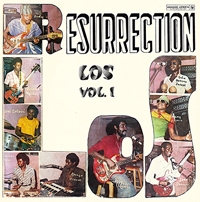
|
LOS CAMAROES
RESURRECTION LOS VOL 1 (Analog Africa)
This was the final album of a once massive Camerounian band who broke up in 1979. It was recorded live in the Mango Bar, Yaoundé and has laid-back vocals with a smoldering guitar. Lead guitar wizard Messi Martin has a catch-all approach to Makossa, Bikutsi and even Cavacha in the breakdowns and solos. The disc comes out on vinyl in a limited edition at the end of September. There's a big room sound to the drums and loads of Echoplex on the guitar as well as the vocal mikes. Oddly it reminds me of my beloved Super Mama Djombo from Guinée-Bissau more than other Camerounian bands. I even get a feel of Angola in there. Whatever it is, legendary is a fair epithet, and once again we owe Analog Africa bigtime for finding it. Analog's man-on-the-spot Samy Ben Redjeb explains how the music evolved. Bikutsi was traditionally played on balafon but Messi chewed up bits of paper and stuck them under his strings to deaden them and give his guitar a balafon sound. This drove the fans wild. Despite massive radio hits and local popularity, the band fell apart by the mid-70s: the solid grounded leader Jean Gabari could not longer contain the quixotic lead guitarist Messi. Then in 1979 a businessman asked them to reform for one more round. They opted for playing live in a club, rather than the studio and just picked up where they had left off, thriving off the energy of the crowd. It is shimmering and exciting music. There was no volume two, sadly, as Jean Gabari, the bandleader, was already ill, and was forced to retire. As usual none of the members ever reached these heights again, so we are fortunate to have this gem literally resurrected for us. |
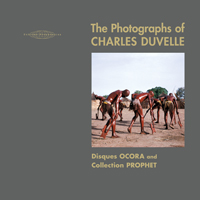
|
There's a brilliant travel book by Redmond O'Hanlon called Into the Heart of Borneo. He and a friend undertake a dangerous trek into the depth of the jungle, hoping to meet a tribe that have had no contact with the outside world in over 50 years. One of the Rockefellers, Michael, was allegedly eaten while trying to make contact with these people in 1961. You learn that you don't pee in the river while bathing because there's a spiny fish that loves the warm piss and will swim up the flow and lodge itself in your urethra. But when the intrepid explorers get to their destination they find natives hoping they have batteries so they can play their boomboxes again and hear the Michael Jackson tapes they love so much. For much of the twentieth century, Africa had a similar shivering-dread/romantic appeal for daredevil travelers, but by the mid-century music explorers were going armed with reel-to-reel recorders and capturing the local music made in villages. While Hugh Tracey was working his way North from Southern Africa, the French National Radio had a man on the spot in the form of Charles Duvelle who covered West and Central Africa, then the Indian Ocean, South-East Asia and the South Pacific. Duvelle grew up in Laos, Vietnam and Cambodia, where his father was a colonial governor. Returning to France when he was 9, he studied classical piano and began to compose, and by chance came across a collection of tapes recorded in West Africa held by radio station France d'Outre-Mer. He offered to organize them and soon had a job. He saw a chance to escape the drab motherland and get back to the bright tropics. His radio station sent him first to Niger in 1961 to help set up a radio station there and he found many badly recorded tapes, done in the studio, and told his hosts that since the music was originally played in the field, as it were, they should go and capture it in situ. He set out with the radio host, who was his entrée to the villages, and brought along a Nagra tape deck and a Sennheiser mike. With griots or small ensembles he was able to set up his mike out of the wind and capture their performance, but he also got excited by the possibility of listening in on ceremonies and capturing the sound by becoming part of the action, moving around and adjusting his set-up so, in a sense, improvising with his recording equipment. Returning to France he issued three LPs: those from Upper Volta and Ivory Coast won the Grand Prix du Disque, and not only established him as a music producer but created a market for this music among anthropologists, musicians, travelers and fans in general. Duvelle ended up in charge of the sound archives of OCORA (Office de Coopération Radiophonique), which was established in 1964. The success of these early records led to the deluxe series published by OCORA with gatefolds, cloth covers, embossing, and booklets of photographs and notes that make these discs so attractive. Duvelle returned to Africa, visiting Cameroon and C.A.R. in 62, Dahomey (Benin) and Madagascar in 63, Kenya in 65, Congo (Zaire) in 66, Senegal in 1967, and then on to New Guinea in 1974 and so on. He was involved with FESTAC 77 and, bizarrely, the soundtrack to Fellini's Satyricon. The surreal juxtaposition struck Duvelle as a brilliant idea, making the African music seem like contemporary avant-garde music. Also in 1977 his field recordings from Burundi were selected by Carl Sagan to go on the gold disc sent into deep space aboard the Voyager spacecraft. And then those recordings of Burundi drummers were appropriated by Burundi Black. He felt that some of the royalties should go back to the people who created the originals so assigned the rights to the Burundi embassy. Here, in appreciation of Duvelle, we have a book the size of an LP with 230 pages of his photographs of musicians from all over the world, plus a discography (including 94 full-color thumbnails), OCORA catalogues from 1964 to 73, notes, articles and two CDs, one of African music, one of Indian. There are a few tracks from Papua incongruously interspersed in the African side, though one or two fit into the flow. This is a celebration of a remarkable individual and, for those like me, who grew up listening obsessively to the OCORA pygmy and ritual recordings, not to mention the mesmerizing Valiha Madagascar set, this is a wonderful treat. Rakotozafy from Madagascar became a celebrity in the world music world with his home-made bicycle spoke zither and you can hear him rock out on "Samy faly (Everyone can find happiness)" here. There's a thumb piano duet, a striking (ahem) xylophone piece from Gabon and another from Guinea which makes an interesting contrast. Then out of the blue we hear a bopal solo, which is a reed instrument made from a single millet stem, played by Moussa Sandé, a Peul shepherd, who just wails for 6 minutes. This Burkinabe could get up on the bandstand with Pharoah Sanders and fit in just fine. More balafons complete the African set. The second disc is a soothing collection of South Asian music including bansuri flute and drone from India and mouth organ from Laos. It's a completely different mood but rounds out the picture of this cosmopolitan and groundbreaking music pioneer. |
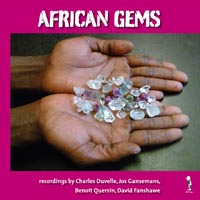
|
The Charles Duvelle commemorative album, which I reviewed above, got me to dig out some of my treasured OCORA albums and I started looking at the names of the people who recorded the music. Some other music pioneers, Hugh Tracey and John Low have been lionized, not only in the Sharp Wood Series, but also by Original Music of John Storm Roberts who produced wonderful reissues of their recordings. What convinced me to buy African Gems was partly that it's what you might call "tribal Africa's greatest hits," but also that Sharp Wood's A&R man, Michael Baird, is a percussionist and drummer and is going to have a different take on what the great field recordings are from your humble reporter (I admit I got my Doctor of Rhythm doctorate from a mail-order college who gave me credit for "life experience"). The importance of these recordings is obvious: between 1965 and 1984 four white men, an Englishman, a Frenchman, and two Belgians, traveled the heart of Africa recording tribal music. Since then war, famine, HIV/AIDS, not to mention the onrush of modernity, have made this traditional music quietly disappear from the earth. But they captured vital musical moments, documents of life as valid as books or movies, maybe more so because of their immediacy. Tourists go looking for it, and perhaps are treated to a mock or recreated initiation ceremony but things slide out of reality, lose their context. In 1983 I visited the Mbuti pygmies (first celebrated by Colin Turnbull), and they put on a concert for my companions and me; they hocketed, jumped about imitating monkeys and generally tore the place up -- for a small fee. We spent a week camped near them in their forest village made of leaves and twigs, and traded them sugar and flour for pot, or to take us hunting. We were offered precious stones (probably bogus), gold (ditto) and even bark cloth, which was lovely but too fragile to transport. I traded a thrift store HARVARD t-shirt for a lovely sanza (thumb piano). (The t-shirt was immediately turned for cigarettes to the local "bigmies" -- normal-sized Africans who lived off the pygmies.) Several of the little people wore necklaces that had stones and seedpods on them. One day I asked one of them who spoke French the significance of those necklaces. Some Italians were here a few months ago and gave them to us, he said, would you like one? I have no doubt one of those necklaces is now in some ethnographic collection with a note, "Ituri rainforest 1983: Mbuti pgymy." So to the disc: the opening track comes from OCORA 25 Cameroun (the one with the cover that was plagiarized by Analog Africa for their disco reissue). It is outstanding, but then so are the 11 cuts that follow. A track like "Mbilé" by a kendé (xylophone) soloist is so rich you have a hard time believing it's only one performer. He accompanied a wrestling match in Chad in 1966 and here the track is restored to its full length. The kendé is an upright xylophone struck with four mallets, according to Duvelle, who also took a photo of the performer. Then we are treated to the "traffic jam" effect of seven ivory horns with percussion (Duvelle in Congo, also 1966). It's interesting that "out" jazz arose around this time and was also a product of African-American horn players. (Note the use of the word "horn"!) The segue into Alur horns from Uganda is great and the reason I wanted to give Baird the reins on this set! The horns from Chad performing "Sirhélé" are also extra-classic. It too slides seamlessly into one of the mind-blowingest pieces of "world music": "Gandja" music from Centrafrique. This is an initiation ceremony complete with chorus and ankle-rattles but the horn polyphony is completely trance-inducing. I admire the way the ten short themes flow together and marvel at their seeming lack of time signature. The anthology ends with an epic topical song sung to a home-made guitar with the choral singer frantically tapping a bottle. It brings us back to earth, though one can see why this music is the stuff that we sent into space to convince alien lifeforms that we earthlings have soul.
|
